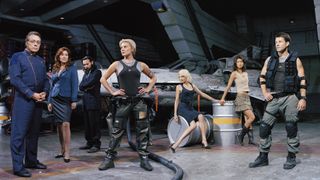If you were looking to create a time capsule of late 1970s pop culture, the original “Battlestar Galactica” would be a prime candidate. Not only was it a clear attempt to capitalize on the immense success of “Star Wars” — to the point where George Lucas’s legal team got involved — but the disco vibes of Glen A. Larson’s high-budget TV space opera firmly anchor it in a specific era.
The show’s family-friendly themes, robot dogs, and flashy, “Saturday Night Fever”-inspired fashion always clashed with its dark central premise, as the remnants of humanity fled from a hostile robotic race known as the Cylons. Despite being canceled after just one season — and the less said about the lackluster Earth-based spin-off “Galactica 1980” the better — it always felt like a concept with more to explore.
Few could have predicted that showrunners Ronald D Moore and David Eick would transform “BSG” 2.0 into one of the most innovative and critically acclaimed TV series of the 21st century — one that spoke volumes about the early 2000s in a way its predecessor did for the ’70s.
Just as it is now, space opera in the early 2000s was dominated by two other long-standing franchises with “star” in their names. On one side, George Lucas’s prequel trilogy was raking in money at the box office but failing to win over critics or older fans. On the other, “Trek” was nearing the end of its 18-year TV run, with “Enterprise” as its last frontier outpost.
The reimagined “Battlestar Galactica” had little in common with either. While the mini-series (essentially a prolonged pilot) that debuted towards the end of 2003 featured plenty of spaceships, artificial beings, and convenient technologies for faster-than-light travel, it was more Earth-like in most other aspects, flaws and all.
The inhabitants of the 12 Colonies of Kobol dressed, behaved, and even talked like us, with Viper spacecraft shooting bullets instead of lasers, and the flawed nature of even the show’s top-notch pilots being relatably highlighted.
Meanwhile, “Battlestar Galactica”‘s iconic robotic foes, the Cylons, were upgraded to look human, and Baltar (the man who betrayed humanity to the machines) was portrayed as a pawn rather than a straightforward villain. His downfall stemmed from personal vanity and failure to see through his manipulative lover’s real intentions, leading to the collapse of an entire civilization. If Sci Fi (as Syfy was known then) had ended the series after the mini-series, the reboot would have been fondly remembered, especially for the twist revealing Boomer as an unknowing Cylon agent in the final shot. But it was with “33,” the first official episode airing on January 14, 2005, that “BSG” truly showed its potential as a timeless show. The contrast with the original series’ early episodes was stark. While the original fleet sought refuge at the pleasure planet of Carillon for relaxation, “33” presented a relentless pursuit by the Cylons every 33 minutes, pushing the crew to their limits. This intense and gripping hour of TV showcased characters making mistakes and facing split-second life-and-death decisions.
Considered one of the greatest sci-fi TV episodes ever, “33” marked the beginning of two outstanding seasons of top-notch viewing. Despite some missteps later on — veering into spiritual themes at times — the show’s reputation was secured. Even a controversial ending, borrowing elements from “The Hitchhiker’s Guide to the Galaxy”, didn’t change that. A significant part of “Battlestar Galactica”‘s success was its departure from the traditional “Star Trek” ethos. Moore, a former “Next Generation” and “Deep Space Nine” writer, had grown frustrated with the idealistic visions of Starfleet’s conflict-free society. In stark contrast, “BSG” presented a morally complex world where humans posed as much danger to each other as the Cylons. Dealing with themes relevant to post-9/11 America, “Battlestar Galactica” dared to tackle tough issues like trust, torture, and moral ambiguity. While set far from Earth, the show addressed weighty topics with nuance and shades of gray.
As part of a wave of high-quality serialized TV, “Battlestar Galactica” was often mentioned alongside acclaimed shows like “The Sopranos” and “The Wire”. Despite being a sci-fi series in a genre previously dismissed as lesser, it earned its place among the best, as Time magazine emphasized when it named “BSG” the top TV show of 2005. While “BSG” didn’t ignite a major space opera revival in TV (it didn’t always draw huge ratings), it left a lasting impact. It influenced future space-set shows like “The Expanse” and even newer “Star Trek” iterations that seemed to borrow from its darker, more mature tone. The potential for yet another reboot is ever-present, given Universal’s continual development of “BSG” projects. As the characters often say in the show, “All this has happened before and will happen again.” The question remains: Can “BSG” 3.0, if it materializes, uphold the legacy of one of the finest sci-fi TV shows of the 21st century? “Battlestar Galactica” is available to stream on Prime Video in the US.






